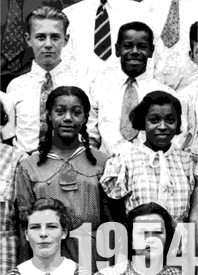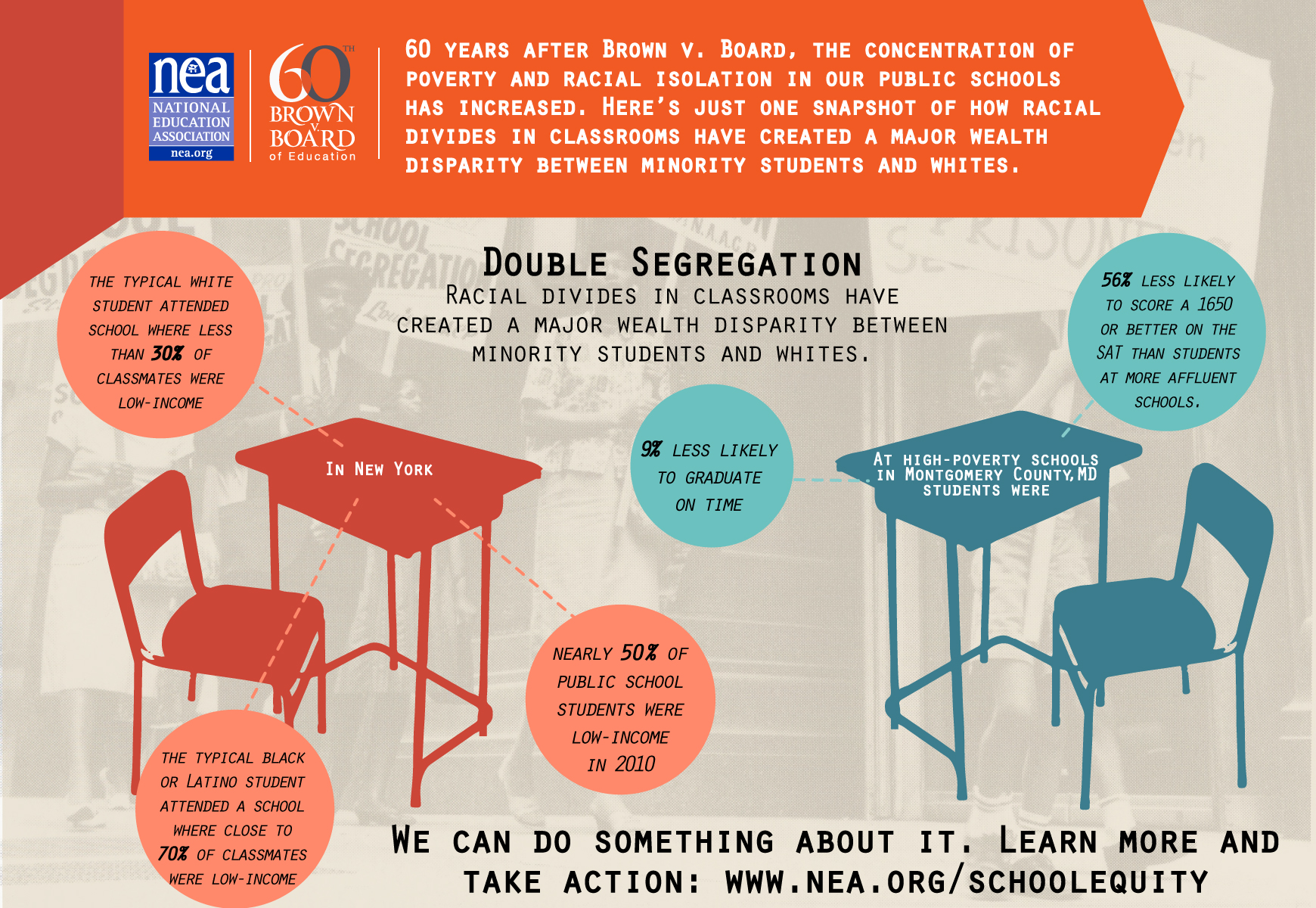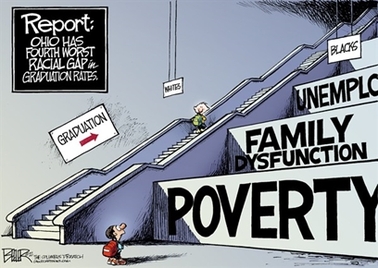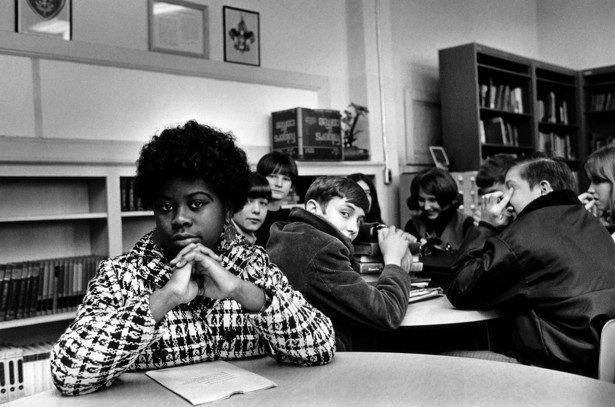By Julie Rine, Minerva Local Education Association
 In 1954, the Supreme Court ruled in Brown v. Board of Education that “separate but equal” public schools for black and whites were not constitutional. Segregating kids based on race had long been the practice and it took the government stepping in to put a stop to it… in theory, at least. In reality, the ruling did not put an end to the matter. Years after the Brown ruling, both Presidents Eisenhower and Kennedy had to deploy federal troops to quash riots in Little Rock, Arkansas and at the University of Mississippi when black students tried to enroll.
In 1954, the Supreme Court ruled in Brown v. Board of Education that “separate but equal” public schools for black and whites were not constitutional. Segregating kids based on race had long been the practice and it took the government stepping in to put a stop to it… in theory, at least. In reality, the ruling did not put an end to the matter. Years after the Brown ruling, both Presidents Eisenhower and Kennedy had to deploy federal troops to quash riots in Little Rock, Arkansas and at the University of Mississippi when black students tried to enroll.
Desegregation was not an easy process, but data shows that at the height of integration in the late eighties, the achievement gap between black and white students was cut in half, primarily because black students, when attending schools with better resources and more experienced teachers, do better.[1][2] No surprise there. Integration works.
But it’s not happening much today.
Google “Brown v. Board of Education” and the results will give you several sites that describe the case in detail. But add the word “today” to that search, and you will find a myriad of articles explaining why, six decades later, American public schools are just as racially segregated as they were in 1954; in many cases, even more so.

One reason is that economic segregation has grown, and there is an undeniable link between race and poverty. According to Communities in Schools President Dan Cardinali, the NEA reports that “Of all public school students today, nearly half are low-income and 44 percent are students of color, and both populations are concentrated in segregated schools. African-American and Latino children are 2 to 3 times more likely to be poor than white children.”[3] In Ohio, we continue to operate under an unconstitutional school funding system based on property taxes. Schools in areas of high poverty have fewer resources to work with, and the kids who attend those schools are often children of color.
 Unfortunately, the initial reason for segregation still exists as well. Take, for instance, the recent situation in Missouri. Normandy, a primarily black school district, lost its accreditation, and its students were going to be bussed to an 85% white district, Francis Howell. At a town hall meeting, Francis Howell parents expressed concern, with comments such as “We don’t want the different areas– I’m going to be very kind– coming across on our side of the bridge, bringing with it everything that we’re fighting today against”[4]. One parent said that Normandy had lost its accreditation because of violence (it did not) and argued that “ I shopped for a school district…I deserve to not have to worry about my children getting stabbed, or taking a drug, or getting robbed because that’s the issue”[5]. The parents’ remarks ranged from stereotypes to blatant racism, and it would be easy to mistake the meeting for one about bussing black kids to a white school in the 1950s.
Unfortunately, the initial reason for segregation still exists as well. Take, for instance, the recent situation in Missouri. Normandy, a primarily black school district, lost its accreditation, and its students were going to be bussed to an 85% white district, Francis Howell. At a town hall meeting, Francis Howell parents expressed concern, with comments such as “We don’t want the different areas– I’m going to be very kind– coming across on our side of the bridge, bringing with it everything that we’re fighting today against”[4]. One parent said that Normandy had lost its accreditation because of violence (it did not) and argued that “ I shopped for a school district…I deserve to not have to worry about my children getting stabbed, or taking a drug, or getting robbed because that’s the issue”[5]. The parents’ remarks ranged from stereotypes to blatant racism, and it would be easy to mistake the meeting for one about bussing black kids to a white school in the 1950s.
In his recent remarks in Flint, Michigan, President Obama noted that we have to lose the “us” and “them” mentality: “We’ve got to break that mindset that says that that neighborhood over there, that’s not my problem; those kids over there, they don’t look like my kids exactly, so I don’t have to worry about them…We’ve got to break that attitude that says somehow there’s an “us” and “them,” and remind ourselves that there’s just one big “we” — the American family, and everybody has got to look out for each other.”[6]

The idea of being one entity instead of several groups is important. When kids grow up in largely segregated neighborhoods and schools, they rarely get to see the world from any perspective other than their own. The world is not as small as it used to be, and it is essential that our kids know how to listen to other points of view from people who may have had different experiences and who hold different beliefs. A recent article in The Week supports the “Breakfast Club” effect, the idea that we benefit from spending time with people who are not exactly the same as us. The writer points out, “The explosion of the digital realm has given us an unprecedented capability to self-segregate, and surround ourselves exclusively by people who think and act like us. For now, high school remains pretty much the last time we are forced into a room with a mix of people that we have little control over.”[7] If our schools are segregated, there is little chance for the “Breakfast Club” effect to take place.
Integration is important for both academic and social development, yet our schools are more segregated than ever. How do we fix this? I don’t have the answers, and I don’t like not having answers, or at least suggestions. Outside of my time at Ohio State, I have never attended or taught at a school with much racial diversity, although there are great socio-economic disparities among my students. As a white, middle-class woman, I have not experienced the pain of being considered an “other”. But as a teacher, I know I am passionate about all students getting the quality education they deserve. As public education is at the very core of our democracy, educators must keep the conversation alive, must continue to discuss the importance of integration with our legislators, and must keep advocating for improvements to the system. I believe this is more of a moral issue than a political one, yet this might be a case where, as in the past, government has to step in.
There are many factors that can make a child’s path to education easier or harder, and many of those factors are out of our control. But once a student crosses the threshold of a school, whether in the nation’s cities, suburbs, or small towns, there should be no doubt that the best resources, facilities, and teachers are waiting to greet him.
[1] “Transcript: The Problem We All Live With – This American Life.” 2015. 10 May. 2016 <http://www.thisamericanlife.org/radio-archives/episode/562/transcript>
[2] “Brown v. Board of Education’s 60th Anniversary Stirs History, Reality …” 2014. 10 May. 2016 <http://www.usnews.com/news/articles/2014/05/16/brown-v-board-of-educations-60th-anniversary-stirs-history-reality>
[3] “Brown v. Board of Education’s 60th Anniversary Stirs History, Reality …” 2014. 10 May. 2016 <http://www.usnews.com/news/articles/2014/05/16/brown-v-board-of-educations-60th-anniversary-stirs-history-reality>
[4] “Transcript: The Problem We All Live With – This American Life.” 2015. 10 May. 2016 <http://www.thisamericanlife.org/radio-archives/episode/562/transcript>
[5] “Transcript: The Problem We All Live With – This American Life.” 2015. 10 May. 2016 <http://www.thisamericanlife.org/radio-archives/episode/562/transcript>
[6] “Read President Obama’s Speech in Flint on Water Crisis | TIME.” 2016. 10 May. 2016 <http://time.com/4318909/barack-obama-speech-flint-michigan-transcript/>
[7] “Why being miserable in high school is good for you – The Week.” 2015. 10 May. 2016 <http://theweek.com/articles/553540/why-being-miserable-high-school-good>
